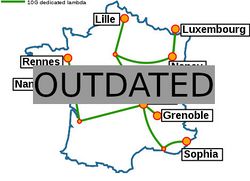Grid5000:Home: Difference between revisions
No edit summary |
No edit summary |
||
| Line 7: | Line 7: | ||
Key features: | Key features: | ||
* provides '''access to a large amount of resources''': | * provides '''access to a large amount of resources''': 15000 cores, 800 compute-nodes grouped in homogeneous clusters, and featuring various technologies: GPU, SSD, NVMe, 10G and 25G Ethernet, Infiniband, Omni-Path | ||
* '''highly reconfigurable and controllable''': researchers can experiment with a fully customized software stack thanks to bare-metal deployment features, and can isolate their experiment at the networking layer | * '''highly reconfigurable and controllable''': researchers can experiment with a fully customized software stack thanks to bare-metal deployment features, and can isolate their experiment at the networking layer | ||
* '''advanced monitoring and measurement features for traces collection of networking and power consumption''', providing a deep understanding of experiments | * '''advanced monitoring and measurement features for traces collection of networking and power consumption''', providing a deep understanding of experiments | ||
Revision as of 20:53, 19 January 2020
|
Grid'5000 is a large-scale and flexible testbed for experiment-driven research in all areas of computer science, with a focus on parallel and distributed computing including Cloud, HPC and Big Data and AI. Key features:
Grid'5000 is merging with FIT to build the SILECS Infrastructure for Large-scale Experimental Computer Science. Read an Introduction to SILECS (April 2018)
Older documents:
|
Random pick of publications
Five random publications that benefited from Grid'5000 (at least 2924 overall):
- Céline Acary-Robert, Emmanuel Agullo, Ludovic Courtès, Marek Felšöci, Konrad Hinsen, et al.. Guix-HPC Activity Report 2022–2023. Inria Bordeaux - Sud Ouest. 2024, pp.1-32. hal-04500140 view on HAL pdf
- Can Cui, Imran Ahamad Sheikh, Mostafa Sadeghi, Emmanuel Vincent. End-to-end Multichannel Speaker-Attributed ASR: Speaker Guided Decoder and Input Feature Analysis. 2023 IEEE Automatic Speech Recognition and Understanding Workshop (ASRU 2023), Dec 2023, Taipei, Taiwan. 10.1109/ASRU57964.2023.10389729. hal-04235774 view on HAL pdf
- Diego Amaya-Ramirez. Data science approach for the exploration of HLA antigenicity based on 3D structures and molecular dynamics. Bioinformatics q-bio.QM. Université de Lorraine, 2024. English. NNT : 2024LORR0071. tel-04708399 view on HAL pdf
- Pierre Epron, Gaël Guibon, Miguel Couceiro. ORPAILLEUR SyNaLP at CLEF 2024 Task 2: Good Old Cross Validation for Large Language Models Yields the Best Humorous Detection. Working Notes of the Conference and Labs of the Evaluation Forum (CLEF 2024), Sep 2024, Grenoble, France. pp.1841-1856. hal-04696012 view on HAL pdf
- Mouhamed Amine Bouchiha. Advancing Blockchain-based Reputation Systems : Enhancing Effectiveness, Privacy Preservation, and Scalability. Computer Science cs. Université de La Rochelle, 2024. English. NNT : 2024LAROS006. tel-04874759 view on HAL pdf
Latest news
Failed to load RSS feed from https://www.grid5000.fr/mediawiki/index.php?title=News&action=feed&feed=atom: Error parsing XML for RSS
Grid'5000 sites
Current funding
As from June 2008, Inria is the main contributor to Grid'5000 funding.
INRIA |
CNRS |
UniversitiesUniversité Grenoble Alpes, Grenoble INP |
Regional councilsAquitaine |


